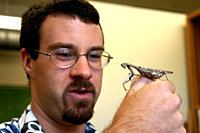|
|
Approaching a female for sex is tantamount to laying his life on the line, but male praying mantises aren't that willing to die for the chance to mate, SUNY Fredonia Biology Professor William D. Brown and his former graduate student Jonathan P. Lelito reported recently in the The American Naturalist.
Their research into the sexual cannibalism of mantids broke new ground in biology by showing strong evidence for the first time that males aren’t willing to trade their lives for sex.
It’s a curious fact that some female creatures in the animal kingdom—insects, spiders, aquatic crustaceans, and scorpions, for example—will kill their sex partners after the act of mating. “There’s been some suggestion out there that maybe males are willing accomplices in the act of sexual cannibalism,” Brown said. “People have gone back and forth on it but there hasn’t been any strong evidence to settle it.” He and Lelito (who is now at Penn State working on a Ph.D.), set up what they thought was the simplest, most straightforward way to find out whether sex or survival was the stronger motivator.
Copulation between praying mantises gets risky for a simple enough reason. “Why do the females bite off their partners’ heads? Because males are a good meal,” Dr. Brown said.
Sexual cannibalism occurs only about 20 percent of the time, just enough to encourage the males to get smarter and smarter as they live another day.
The Fredonia research showed that the hungrier the female, the more likely she is to attack her mate. Brown and Lelito’s measurements showed that male mantids appeared to be able to cue in on her danger level. When she was hungrier, the male slowed down his approach. “He did everything more cautiously and increased his courtship behavior,” Dr. Brown said. Involving a kind of sinuous dance, “courting” was seen when a male mantid approaching a hungrier female would stop at a safe distance and spend some time widely swinging his abdomen and belly. “It may be a signal that he’s a mate, not a food item,” Brown said.
Another variation they created was seeing if a male would make himself less vulnerable to a direct attack, which he did. “Females are visual hunters,” Brown said, noting their heads are almost entirely made of their eyes. “They attack with these raptorial forearms, right in the front. So head-on is the most risky angle for the male to approach and he’ll avoid it.” Male mantids jump on the females’ backs to mate. “He’ll jump from a farther distance when she’s hungrier,” Brown said.
The study has captured the interest of the popular press, and Brown has been interviewed by The New York Times (see the Times' story here). The story has been publicized internationally and translated into other languages, including Japanese, Spanish, German, and Hungarian. “People are fascinated by it,” Brown said. “It’s dangerous sex.”
Brown teaches ecology, evolution and conservation in the Fredonia biology department. Founded in 1867, The American Naturalist is one of the world's most renowned, peer-reviewed publications in ecology, evolution, and population and integrative biology research. It publishes research that advances the knowledge of organic evolution and other broad biological principles.



